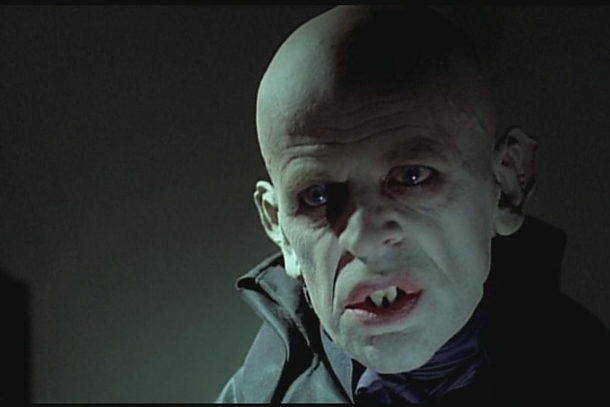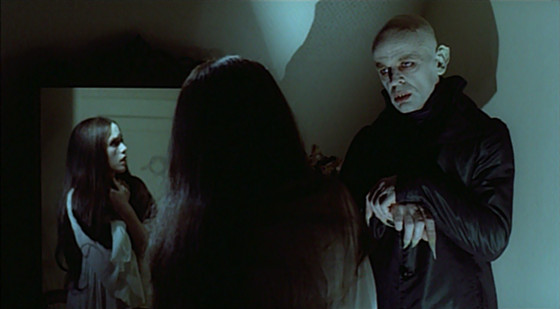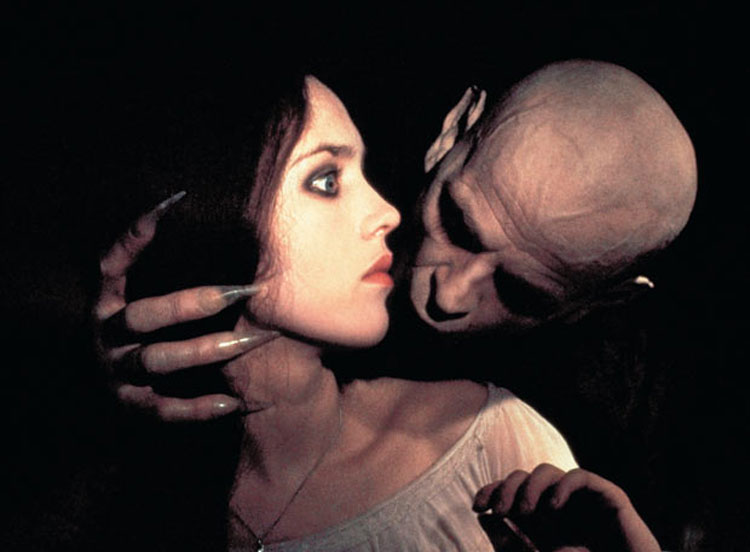
“Death is not the worst. There are things more horrible than death.”
– Count Dracula (played by Klaus Kinski)
Blood on your cool
Pronounced and menacing, Werner Herzog’s redaction of Nosferatu should not be viewed, as he insists, as a remake of F.W. Murnau’s 1922 horror classic of German silent cinema––what Herzog describes as “the greatest German film,”––but what’s more, a laudation to it.
Resolute and mesmerizing, Nosferatu the Vampyre retells the renowned Bram Stoker story with tough teeth and a dash of the surreal. Bruno Ganz (The American Friend, Downfall, Wings of Desire) is Jonathan Harker, a real-estate agent from Wismar, Germany, who treks through the blurred yet beautiful Carpathian Mountains where he is to tailor the relocation of the despondent Count Dracula (Klaus Kinski, brilliant) from his imposing acropolis.
The alternating melancholy/menacing Count is easily and at once infatuated with a small portrait Jonathan carries of his wife, Lucy (Isabelle Adjani, stunning as ever), and agrees almost at once to maneuver his estate to the prospering city of Bremen.
One particularly memorable supernatural sequence involves Dracula’s boat drifting ghost-like into the Bremen landing pier as a drumming mischief of rats, numbering in the thousands, vacates the boat to bring plague, pestilence, and superstition to the polis. It’s easily the stuff of nightmares.
“There are few sequences in Herzog’s oeuvre as chillingly poetic as the one in which the plague descends on Lucy and Jonathan’s hometown. Vermin run rampant, the bourgeoisie cheerily toast their own demise, and the Count himself slinks around, in one of the film’s most haunting images, with a black coffin tucked lovingly under his arm. This is a pinnacle of horror cinema: atmospheric, rhapsodic and—especially in the slow-burn confrontations between Lucy and her otherworldly inamorato—achingly transcendent.”
– Keith Uhlich, Time Out
Flesh of my flesh, blood of my blood

Herzog veers from the erstwhile vampire paradigm in numerously disruptive and tremulous ways. Here Dr. Abraham Van Helsing (Walter Ladengast, previously seen in Herzog’s 1974 masterpiece, The Enigma of Kaspar Hauser) is totally ineffective. A frivolous irrelevance, he’s arrested for murdering the Count. It’s a sharp conceit, particularly considering Jonathan’s part in it all (no spoilers here, but it’s a murderous and devilishly divine twist).
Also altered in this adaptation is Renfield, the delusional Dracula lackey, here a chortling lunatic played by Roland Topor (The Tenant). Adding to the unconventional and capricious role-playing, both Adjani and Ganz, while looking the part of hero and heroine, are too aberrant in their actions and offbeat in their behaviour to register as the archetypes their characters used to be.
It’s a gamble from Herzog that pays off rather well, particularly in startling scenes that are oddly paced or dervish into black-comic enterprise rather than moving the plot or progressing the action. This is Herzog doing horror on his own terms.
Perhaps where Herzog and Murnau are most effectively aligned is in their vision and vestige of humanity via Lucy. As tragic heroine and breathtaking ill-omened angel, Adjani is as paradisiac as she is porcelain-delicate. As tradition allows, she must self-sacrifice to coax the Count to idle after sunrise, when he is most susceptible.
“There won’t be another vampire of the caliber of Kinski… you’ll never see anyone like him again.”
– Werner Herzog
Bela Lugosi’s dead

So much of Herzog’s apocalyptic horror film is shrouded, evocatory, and symbolic. Kinski, at his kinkiest and most abominable, is also self-pitying, forlorn, and wicked. Surely his grim, gauche countenance echoes the ruthlessness of Max Schreck’s manifestation––as do his rat-like teeth and ashen skin head. Kinski’s hollow eyes and protracted fingers allow many old-hat tableaus only now they distend with a different blood.
A transmuting reframing of familiar myths, Herzog’s Dracula is a star-distance from the Tod Browning version for Universal in 1931, and while Bela Lugosi’s Count may well be the definitive, Kinski’s is unforgettably powerful as well.
The vampire figure is often portrayed as tragic––how could it not?––and Kinski’s formalized variation is as visionary, illustrious, and mysterious as it gets. Who but the volatile and consecrated duo of Herzog and Kinski could revamp the summit of vampire tradition into an ominous nightmare? Their iteration of Nosferatu is a dark daydream of unprecedented romantic ferocity and annihilation.
“Another striking quality of [Nosferatu] is its beauty. Herzog’s pictorial eye is not often enough credited. His films always upstage it with their themes. We are focused on what happens, and there are few ‘beauty shots’. Look here at his control of the color palette, his off-center compositions, of the dramatic counterpoint of light and dark. Here is a film that does honor to the seriousness of vampires.”
– Roger Ebert
Then he kissed me

Never to be labelled a genre director, Herzog doing horror is a world of constricted, suffocating spaces, dimness and luster; light and dark diversity very near to unbroken monochrome. Scenes unravel in undue fashion; long takes and static shots juxtapose violently with spasmodic handheld camera.
The subtly shocking opening, famously filmed in the Mummies of Guanajuato museum in Mexico by Herzog himself, shows the naturally mummified remains of victims of a cholera epidemic in the early 1800s, and adds a documentary-like urgency and actual uncertainty to the terrors about to unfold.
In a Herzog film, be it nonfiction or fabulist, one is never sure where the line between real and imagined is decided. There’s too much blur, too much overlap, it’s all ambiguity. And it’s in this boundless cloud that Nosferatu casts a spectral glow.
“The genre of vampire films,” Herzog has said, “requires extreme stylization.” By using dialog sparingly, by ethereal and ghostly music––the stunning score is by electronic avant-garde German band Popol Vuh––by intrusive and restrictive use of space, and by unfamiliar imagery of the human and natural landscape, Herzog brings into existence an unsettling work of art. Nosferatu the Vampyre is a lyrical dark fantasy about death and devotion, a heart of darkness odyssey that only Herzog could express.
Author Bio: Shane Scott-Travis is a film critic, screenwriter, comic book author/illustrator and cineaste. Currently residing in Vancouver, Canada, Shane can often be found at the cinema, the dog park, or off in a corner someplace, paraphrasing Groucho Marx. Follow Shane on Twitter @ShaneScottravis.